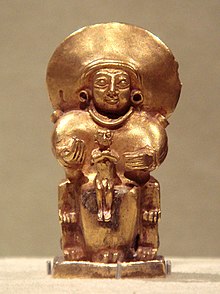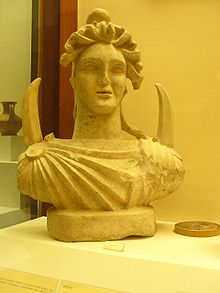This article should specify the language of its non-English content, using {{lang}}, {{transliteration}} for transliterated languages, and {{IPA}} for phonetic transcriptions, with an appropriate ISO 639 code. Wikipedia's multilingual support templates may also be used. (January 2024) |
*Seh₂ul and *Meh₁not are the reconstructed Proto-Indo-European deity of the Sun and deity of the Moon respectively. *Seh₂ul is reconstructed based on the solar deities of the attested Indo-European mythologies, although its gender (male or female) is disputed, since there are deities of both genders.[1] Likewise, *Meh₁not- is reconstructed based on the lunar deities of the daughter languages, but they differ in regards to their gender.
| *Seh₂ul | |
|---|---|
Sun deity | |
 Possible depiction of the Hittite Sun goddess holding a child in her arms from between 1400 and 1200 BC. | |
| Abode | Sky |
| Planet | Sun |
| Symbol | Chariot, solar disk |
| Day | Sunday |
| Equivalents | |
| Albanian equivalent | Dielli |
| Celtic equivalent | Sulis |
| Etruscan equivalent | Usil |
| Greek equivalent | Helios |
| Hindu equivalent | Surya |
| Roman equivalent | Sol |
| Hittite equivalent | UTU-liya |
| Lithuanian equivalent | Saulė |
| Zoroastrian equivalent | Hvare-khshaeta |
| Germanic equivalent | Sowilō |
| *Meh₁not | |
|---|---|
Moon deity | |
 Bust of Men a deity considered descended from *Meh₁not | |
| Abode | Sky |
| Planet | Moon |
| Day | Monday |
| Equivalents | |
| Albanian equivalent | Hëna |
| Greek equivalent | Mene (Selene) |
| Roman equivalent | Luna |
| Slavic equivalent | Myesyats |
| Hittite equivalent | Kašku |
| Phrygian equivalent | Men |
| Zoroastrian equivalent | Mah |
| Latvian equivalent | Mēness |
| Germanic equivalent | Máni |
The daily course of *Seh₂ul across the sky on a horse-driven chariot is a common motif among Indo-European myths.[note 1] While it is probably inherited, the motif certainly appeared after the introduction of the wheel in the Pontic–Caspian steppe about 3500 BC, and is therefore a late addition to Proto-Indo-European culture.[3]
The Sun deity
edit*Seh₂ul is reconstructed based on the Greek god Helios, the Greek mythological figure Helen of Troy,[4][5] the Roman god Sol, the Celtic goddess Sulis / Sul/Suil, the North Germanic goddess Sól, the Continental Germanic goddess *Sowilō, the Hittite goddess "UTU-liya",[6] the Zoroastrian Hvare-khshaeta[6] and the Vedic god Surya.[7]
In the mythologies of the daughter languages (namely, Baltic, Greek and Old Indic), the sun deity crosses the sky in a horse-driven chariot or wagon. However, Mallory and Adams caution that the motif is not exclusively Indo-European, and mention evidence of its presence in Mesopotamia.[8]
A character related to the Sun deity is the 'Sun-maiden'.[9] Examples are 'Saules meita', the daughter of Saulé in Baltic tradition, and Sūryā, daughter to Indic Sun god Sūrya.[10] Scholars also posit Helen of Troy, from Greek mythology, was another example of the 'Sun-maiden'.[7][11]
In Albanian tradition there is E Bija e Hënës dhe e Diellit, "the Daughter of the Moon and the Sun", who is a light divine heroine, referred to as pika e qiellit ("drop of the sky" or "lightning"), which falls everywhere from heaven on the mountains and the valleys and strikes pride and evil. She defeats the kulshedra, the archetype of darkness and evil in Albanian mythology.[12][13][14] In some Albanian traditions the Sun (Dielli) and the Moon (Hëna) are regarded as husband and wife, and in others as brother and sister. In the case of E Bija e Hënës dhe e Diellit the Sun is her father and the Moon is her mother.[15][16]
The Moon deity
edit*Meh₁not- is reconstructed based on the Norse god Máni, the Slavic god Myesyats,[note 2][6] and the Lithuanian god *Meno, or Mėnuo (Mėnulis).[19] Remnants of the lunar deity may exist in Latvian moon god Mēness,[20] Anatolian (Phrygian) deity Men;[21][20] Mene, another name for Selene, and in Zoroastrian lunar deity Mah (Måŋha).[22][23][24]
Alternative myth
editAlthough the sun was personified as an independent deity,[25] the Proto-Indo-Europeans also visualized the sun as the "lamp of Dyēws" or the "eye of Dyēws", as seen in various reflexes: "the god's lamp" in Medes by Euripides, "heaven's candle" in Beowulf, or "the land of Hatti's torch", as the Sun-goddess of Arinna is called in a Hittite prayer;[26] and Helios as the eye of Zeus,[27][28] Hvare-khshaeta as the eye of Ahura Mazda, and the sun as "God's eye" in Romanian folklore.[29] The names of Celtic sun goddesses like Sulis and Grian may also allude to this association: the words for "eye" and "sun" are switched in these languages, hence the name of the goddesses.[30]
Albanian solemn oaths are taken "by the eye of the Sun" (për sy të Diellit), which is related to the Sky-God worship (Zojz).[31]
Egyptian mythology is unrelated to Indo-European mythology so there is unlikely any historical link, but the metaphor of Eye of Ra was used in it too.
See also
editNotes
editReferences
edit- ^ West 2007, p. 195-196.
- ^ Agostini, Domenico; Thrope, Samuel. The bundahišn: The Zoroastrian Book of Creation. New York: Oxford University Press, 2020. p. 19. ISBN 9780190879044
- ^ Fortson 2004, p. 23.
- ^ O'Brien, Steven. "Dioscuric Elements in Celtic and Germanic Mythology". In: Journal of Indo-European Studies 10:1–2 (Spring–Summer, 1982), pp. 117–136.
- ^ Meagher, Robert E. (2002). The Meaning of Helen: In Search of an Ancient Icon. Bolchazy-Carducci Publishers. pp. 46ff. ISBN 978-0-86516-510-6.
- ^ a b c Gamkrelidze & Ivanov 1995, p. 760.
- ^ a b Mallory & Adams 1997, p. 232.
- ^ Mallory & Adams 1997, p. 278.
- ^ West 2007, p. 227-232.
- ^ Mallory & Adams 1997, p. 556.
- ^ West 2007, p. 230-231.
- ^ Tirta 2004, pp. 72, 128.
- ^ Shuteriqi 1959, p. 66.
- ^ West 2007, p. 233.
- ^ Tirta 2004, pp. 72, 128
- ^ Dushi 2020, p. 21
- ^ Jones, Prudence; Pennick, Nigel (1995). A History of Pagan Europe. Routledge. p. 186. ISBN 978-1-136-14172-0.
- ^ Dixon-Kennedy, Mike (1998). Encyclopedia of Russian and Slavic myth and legend. p. 188. ABC-CLIO. ISBN 978-1-57607-130-4
- ^ Mallory & Adams 1997, p. 385.
- ^ a b Lurker, Manfred. The Routledge Dictionary Of Gods Goddesses Devils And Demons. Routledge. 2004. p. 123. ISBN 978-04-15340-18-2
- ^ Keneryi, Karl (1951). The Gods of the Greeks. Thames & Hudson. pp. 196–197; Hammond, N.G.L. and Howard Hayes Scullard (editors), The Oxford Classical Dictionary. Second edition. Oxford University Press, 1992. "SELENE" entry. pp. 970–971. ISBN 0-19-869117-3
- ^ Beekes, Robert (1982). "Gav. må, the Pie word for 'moon, month', and the perfect participle" (PDF). Journal of Indo-European Studies. 10: 53–64.
- ^ York, Michael (August 1993). "Toward a Proto-Indo-European vocabulary of the sacred". WORD. 44 (2): 235–254. doi:10.1080/00437956.1993.11435902.
- ^ Lurker, Manfred. The Routledge Dictionary Of Gods Goddesses Devils And Demons. Routledge. 2004. p. 115. ISBN 978-04-15340-18-2
- ^ Mallory & Adams 2006, p. 427.
- ^ West 2007, p. 195.
- ^ Sick, David (2004). "Mit(h)ra(s) and the Myths of the Sun". Numen. 51 (4): 432–467. doi:10.1163/1568527042500140.
- ^ Bortolani, Ljuba Merlina (2016). Magical Hymns from Roman Egypt: A Study of Greek and Egyptian Traditions of Divinity. Cambridge University Press. ISBN 9781316673270.
- ^ Ionescu, Doina; Dumitrache, Cristiana (2012). "The Sun Worship with the Romanians" (PDF). Romanian Astronomical Journal. 22 (2): 155–166. Bibcode:2012RoAJ...22..155I.
- ^ MacKillop, James. (1998). Dictionary of Celtic Mythology. Oxford: Oxford University Press ISBN 0-19-280120-1 pp.10, 16, 128
- ^ Cook 1964, p. 197.
Sources
edit- Cook, Arthur Bernard (1964) [1914]. Zeus: Zeus, god of the bright sky. Zeus: A Study in Ancient Religion. Vol. 1. Biblo and Tannen.
- Dushi, Arbnora (2020). "The Sister-Brother Recognition Motif in the Albanian Folk Ballad: Meaning and Contexts within the National Culture". Tautosakos Darbai. 59: 17–29. doi:10.51554/TD.2020.28363. S2CID 253540847.
- Fortson, Benjamin W. (2004). Indo-European Language and Culture. Blackwell Publishing. ISBN 1-4051-0316-7.
- Gamkrelidze, Thomas V.; Ivanov, Vjaceslav V. (1995). Winter, Werner (ed.). Indo-European and the Indo-Europeans: A Reconstruction and Historical Analysis of a Proto-Language and a Proto-Culture. Trends in Linguistics: Studies and Monographs 80. Berlin: M. De Gruyter.
- Mallory, James P.; Adams, Douglas Q. (1997). Encyclopedia of Indo-European Culture. London: Routledge. ISBN 978-1-884964-98-5.
- Mallory, James P.; Adams, Douglas Q. (2006). The Oxford Introduction to Proto-Indo-European and the Proto-Indo-European World. Oxford, England: Oxford University Press. ISBN 978-0-19-929668-2.
- Shuteriqi, Dhimitër S. (1959). Historia e letërsisë shqipe. Vol. 1. Universiteti Shtetëror i Tiranës, Instituti i Historisë dhe Gjuhësisë.
- Tirta, Mark (2004). Petrit Bezhani (ed.). Mitologjia ndër shqiptarë (in Albanian). Tirana: Mësonjëtorja. ISBN 99927-938-9-9.
- West, Martin L. (2007). Indo-European Poetry and Myth. Oxford, England: Oxford University Press. ISBN 978-0-19-928075-9.